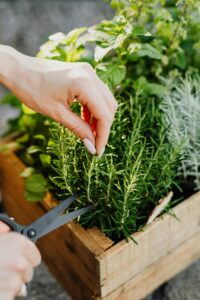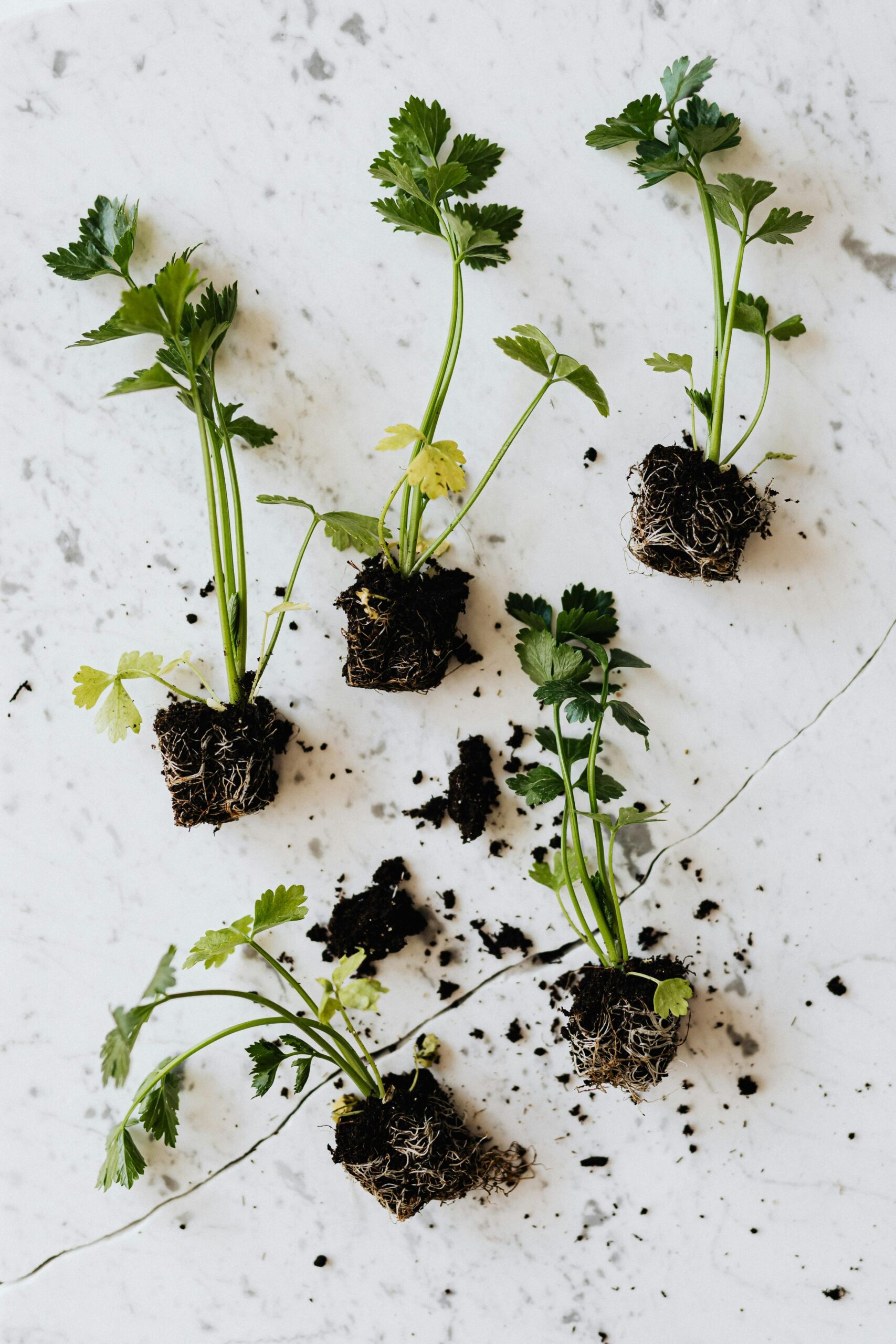Herb gardening is a delightful hobby that brings fresh flavors to your kitchen and a touch of green to your home. However, even the most enthusiastic gardeners can struggle with the balance of watering their herbs just right. Overwatering and underwatering are common problems that can stunt growth, cause diseases, or even kill your plants. Fear not, fellow green thumb! In this guide, we’ll dive into how to identify and fix overwatering and underwatering in some of the most popular culinary herbs.
1. Basil: The Sensitive Superstar
Basil is a beloved herb, often the star of many kitchens. But it’s a bit of a diva when it comes to water.
Identifying Overwatering in Basil:
- Yellowing Leaves: The first sign is usually yellow leaves, starting from the bottom of the plant.
- Wilting Despite Wet Soil: If the soil is moist but the plant looks droopy, overwatering could be the culprit.
- Root Rot: A telltale sign is a foul smell from the soil, indicating root rot.
Fixing Overwatering:
- Check Drainage: Ensure your pot has good drainage. Waterlogged soil is a basil killer.
- Let it Dry Out: Allow the soil to dry out before watering again. Basil prefers slightly moist soil, not drenched.
- Trim Affected Leaves: Remove any yellow or wilting leaves to help the plant recover.
Identifying Underwatering in Basil:
- Crispy, Brown Leaves: Dry, brittle leaves are a sign of underwatering.
- Drooping Plant: While drooping can also mean overwatering, dry soil paired with wilting is a sign of thirst.
Fixing Underwatering:
- Consistent Watering Schedule: Water your basil regularly, ensuring the soil stays moist but not soggy.
- Mulching: Add a layer of mulch to help retain soil moisture.
2. Thyme: The Drought-Tolerant Wonder
Thyme is a hardy herb that doesn’t need much pampering, but it still needs the right care to thrive.
Identifying Overwatering in Thyme:
- Yellowing Leaves: Just like basil, thyme leaves will turn yellow if overwatered.
- Moldy Soil: Persistent dampness can lead to mold growth on the soil surface.
- Wilting Despite Moist Soil: Overwatered thyme will wilt even though the soil is wet.
Fixing Overwatering:
- Improve Drainage: Make sure your thyme’s pot has excellent drainage. Consider adding sand or perlite to the soil mix.
- Water Sparingly: Water thyme less frequently, allowing the soil to dry out between waterings.
Identifying Underwatering in Thyme:
- Dry, Brittle Leaves: Thyme will show signs of dehydration with dry, curling leaves.
- Stunted Growth: If your thyme isn’t growing much, it could be due to lack of water.
Fixing Underwatering:
- Deep Watering: When you water thyme, water deeply to encourage strong root growth.
- Regular Checks: Monitor soil moisture regularly and water when the top inch of soil is dry.

3. Rosemary: The Tough Yet Thirsty Herb
Rosemary is known for its resilience, but even this tough herb can suffer from watering issues.
Identifying Overwatering in Rosemary:
- Yellow, Dropping Leaves: Overwatered rosemary will have yellowing leaves that drop off.
- Soggy Soil: Persistently wet soil can lead to root rot.
- Mildew Smell: A mildew smell from the soil indicates overwatering.
Fixing Overwatering:
- Check Soil Drainage: Ensure your rosemary has well-draining soil and a pot with drainage holes.
- Reduce Watering Frequency: Allow the soil to dry out between waterings. Rosemary prefers drier conditions.
Identifying Underwatering in Rosemary:
- Brown, Needle-Like Leaves: Rosemary’s leaves will turn brown and dry out if it’s underwatered.
- Drooping Plant: Like basil and thyme, rosemary will droop if it needs water.
Fixing Underwatering:
- Regular Watering: Water rosemary regularly, ensuring the soil gets a good soak but is allowed to dry out between waterings.
- Mulching: Mulch around the base of the plant to retain moisture.
4. Cilantro: The Tricky Customer
Cilantro, or coriander, is a versatile herb but can be a bit finicky with its water needs.
Identifying Overwatering in Cilantro:
- Yellowing Leaves: Like other herbs, cilantro leaves turn yellow when overwatered.
- Wilting Despite Moist Soil: Overwatered cilantro will appear limp even when the soil is wet.
- Root Rot: Overwatering can lead to root rot, causing a foul smell and mushy roots.
Fixing Overwatering:
- Ensure Proper Drainage: Use pots with drainage holes and well-draining soil.
- Reduce Watering Frequency: Allow the top inch of soil to dry out before watering again.
- Remove Affected Parts: Trim any yellowing or wilting leaves to help the plant recover.
Identifying Underwatering in Cilantro:
- Dry, Curling Leaves: Cilantro leaves will dry out and curl if underwatered.
- Wilting Due to Dry Soil: If the soil feels dry and the plant is wilting, it’s time to water.
Fixing Underwatering:
- Consistent Moisture: Keep the soil consistently moist but not waterlogged. Cilantro prefers steady, moderate watering.
- Shade During Heat: Provide some shade during the hottest part of the day to reduce water loss and stress on the plant.
General Tips for Healthy Herbs
- Know Your Herbs: Different herbs have different water needs. Group herbs with similar requirements together.
- Use the Right Soil: Well-draining soil is crucial to prevent overwatering issues.
- Monitor Moisture Levels: Use a soil moisture meter or simply stick your finger in the soil to check its moisture level.
- Avoid Watering at Night: Watering in the morning allows the soil to dry out during the day, preventing fungal growth.
By understanding the signs of overwatering and underwatering, and knowing how to address them, you’ll be well on your way to a thriving herb garden. Happy gardening, and may your herbs grow lush and flavorful!
Check out Organic Container Gardening!


I’m glad to have seen this. I’d love to start planting some herbs. I don’t use them much, but I’d love to start using them more often.
These are great tips and signs to look out for in case of over-watering! I sometimes have a hard time telling how much or how often is just right. Armed with this info, I’ll be able to figure it out a bit better now that I have an idea of what to consider.
This is great information that you shared with us. I struggle with this; I don’t know if I am putting the right amount of water in my herb garden.
I am not good with keeping herbs, and it is important to know your plants and how to care for them. Herbs are such a great plant to keep up to be able to use.
I use a lot of herbs in my cooking and I’ve been wanting to have an herb garden. Thank you for these tips!
My husband’s hobby is gardening, we have a small garden that he always looks after. I’ll pass on to him these precious tips. Thank you for sharing.
, I found your tips on identifying and fixing overwatering and underwatering in culinary herbs incredibly helpfu
Thanks so much for putting together this comprehensive list. I have a kitchen herb garden and these tips will be so helpful.
this is such a timely and useful post for me as i explore gardening a little more this year
I have been interested in growing my own herbs. Thanks for your helpful tips.